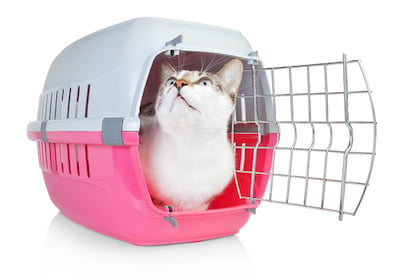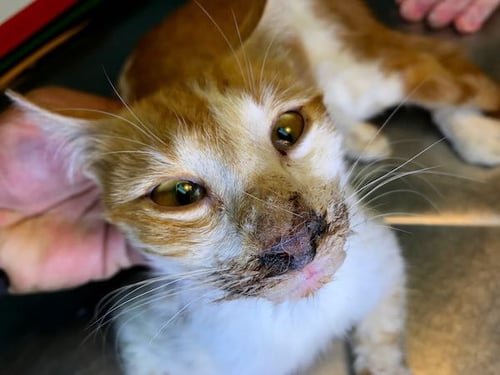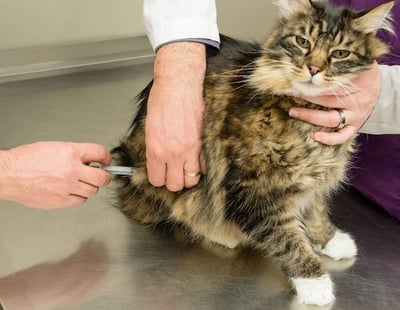- en
FeLV and FIV are among the most common viruses in cats, and FIP is less common but important to know about. Each has different levels of prevention and management. Read on to learn how to best manage these conditions and infections.
Quick Links

Living in shelters can be challenging, as FeLV cats have to be housed separately from all other cats. Adopting and giving these kitties a chance to live in a loving home is such a gift to give. The virus only affects cats, so they can live with other animals, like dogs and rabbits. However, they should be the only cat or live with another FeLV-positive feline. And they should only be kept indoors.
Our mission is to help save dogs' and cats’ lives through our educational content. To support our efforts, this page may contain affiliate links. We earn a commission for qualifying purchases – at no cost to you.
This transmittable ribonucleic acid (RNA) retrovirus, which was first discovered in the 1960s, is one of the most common infectious diseases of cats and is highly contagious. In the United States, approximately 2 to 3 % of all cats are affected. Since the development of effective vaccines and testing procedures, there has been a significant decrease in the incidence of FeLV over the past 30 years.
A number of diseases and infections in cats are due to FeLV since it severely inhibits a cat’s immune system. Included in this list are anemia, leukemia, kidney disease, and lymphosarcoma (cancer). FeLV-infected cats can suffer severe illnesses from common bacteria, viruses, protozoa, and fungi that would not usually affect healthy cats.
Approximately 30 % of cats that are exposed to the virus manage to eliminate the infection within a few months, even without treatment. But it is important to realize, that during those months that the cat is carrying the virus, damage is being done to the body that can lead to other diseases later in life. Within 2 to 3 years after infection, greater than 50% of cats with leukemia in their blood die.
Oftentimes, symptoms during early stages of infection with FeLV are not present right away. It can potentially take weeks, months, and even years for the virus to affect an infected cat’s health. Cats may experience recurring cycles of sickness and good health, or a cat may gradually worsen over time.

This virus is a member of the lentivirus subfamily of retroviruses. It was first recognized in the 1980s, and it is specific to cats. It attacks and disrupts a cat’s immune system, which makes them more susceptible to other infections. FIV is an infectious disease of cats around the world but not a common cat infection. Cats showing evidence of exposure to the virus is only 1% to 5%.
There is no cure for FIV, and as far as it is known, once a cat is infected, it is for life. With proper care and immune support, many cats infected with FIV live average life spans.
Cats infected with FIV can live normally for years before they eventually have something that challenges their immune system. It can be any normally harmless virus, bacteria, protozoa, or fungi present in everyday environments. Therefore, FIV's typical signs are often due to other infections that don’t heal. Many of these signs are non-specific.
FIP is a mutated strain of the feline coronavirus. Typically, most strains of the virus are found in the gastrointestinal tract (referred to as feline enteric coronavirus), but they do not cause significant disease. FIP, however, is a progressive and fatal systemic immune-mediated disease that results when there is a mutation of the enteric coronavirus. The result is an inflammatory reaction around vessels and tissues where the infected cells are present. The typical locations of these cells are the abdomen, kidney, and brain. The percentage of cats that actually develop FIP (only about 5% to 10% of those affected with feline enteric coronavirus) is small when you consider that the number of cats carrying antibodies to the feline coronavirus is up to 50% of the general population.
Note: This feline coronavirus has nothing to do with the COVID-19 virus affecting humans.
Generally, the initial symptoms noted are non-specific. They can include low energy, little to no appetite, weight loss, inactive, and consistently changing fever. Other symptoms typically appear several days to weeks after this initial period.
Most of the time when cats are exposed to feline coronavirus, via ingestion or inhalation of oral/nasal secretions or feces, they can develop an immune response. This immune response protects them from getting sick or having symptoms. Unfortunately, death is inevitable for those that don’t develop an immune response and the disease develops.
FeLV is highly contagious. It is transmitted in body fluids such as saliva, nasal discharge, urine, feces, and the milk of infected mother cats. It is also possible for it to be transmitted across the placenta in pregnant cats. There are several ways for cat-to-cat transfer to occur.
Any breed of cat can be infected, and it is typically seen in cats between 1 and 6 years of age. Although, kittens can be infected at birth and while nursing. Kittens are at greater risk than adult cats if exposed. It appears that resistance to the virus increases as cats age.
Females appear to be infected less than males. The theory is that male cats, particularly non-neutered, tend to fight more frequently than female cats. Exposure to outdoor cats can also increase the risk of infection.
It is possible that a cat exposed to FeLV will not develop a persistent infection, so the symptoms can be hidden. Therefore, a non-infected cat can be infected by coming into contact with new cats entering a home. They should be tested before they are allowed contact with resident cats.

The virus is shed in saliva and is transmitted by bite wounds. Cats are not generally infected by casual contact with one another because the virus doesn’t survive well outside the cat’s body.
Additionally, the virus can be spread through contact with infected blood. If infected blood enters a cat’s body through a wound or via a blood transfusion, they are at risk of getting the virus. Mutual grooming and shared bowls do not appear to be a way cats spread the infection to each other. Only rarely is the disease transmitted to the kittens during pregnancy. There is an increased risk of infection to the kittens if mother cats are infected when they are pregnant.
Once a cat is infected, it is infected for life. But there may not be evidence of the disease for weeks, months, or years. The disease mounts an attack on the cat’s immune system. Once something, such as a virus, bacteria, etc., challenges their immune system, they become ill.
Un-neutered male cats that have outdoor access tend to be those most highly affected. The reason is they tend to be more likely to fight with other cats.
While cats of all ages are affected worldwide, the disease is most common in cats less than 2 years old. FIP may be more likely to develop in the following breeds – Abyssinian, Bengal, Birman, Himalayan, Ragdoll, and Devon Rex. There also seems to be a higher prevalence of the disease in multi-cat households, shelters, and catteries. Stress caused by surgery or other infections seems to predispose cats to FIP.
The virus is shed in oral and nasal secretions, feces, and potentially urine. Cats become infected by ingestion or inhalation while in close contact. Typically, cats can transmit the virus for a few months. But there is a small percentage of cats that are contagious with the virus for life. The virus usually does not survive for more than 24 to 36 hours in the environment.
There is no cure for FeLV infection at this time. Your veterinarian will prescribe medications that will treat the secondary infections that result from the disease. Normally your cat will not be hospitalized, but if they have any severe infections or other complications (like dehydration), hospitalization may be needed. If your cat developed cancer as a result of FeLV, your vet might recommend chemotherapy.
It is important that you have your cat examined every 6 months by their veterinarian. The purpose is to prevent complications from the virus as well as identify problems early. It may be recommended to have your cat’s teeth cleaned, and teeth extractions may be necessary, as dental infections can cause complications. If your cat does show any signs of illness, immediately have them evaluated by their vet.
It is important to keep your cat indoors. Provide them with a proper diet. If there is diarrhea, kidney damage, etc., as a result of FeLV, your cat may need a special diet. Consult with your veterinarian to see if any supplements can be added to their diet to boost their immune system.

There is no cure for FIV, but your cat can live a normal and healthy life if they are cared for appropriately. Once your cat has been diagnosed by their veterinarian, the best thing you can do for them is the following:
Be sure at the first sign of illness that you have your cat evaluated by their vet so that prompt and aggressive treatment can be started. If your cat develops one or more bad illnesses due to infection or has a continuous fever with weight loss, that can be a poor indicator for their recovery and survival.
Anytime your cat becomes sick, it is essential to have them evaluated by their veterinarian. There are no routine tests to diagnose FIP. Your cat’s veterinarian will only test after they have strong evidence based on clinical signs that FIP may be the cause of illness. There is no cure for this disease. While being treated, if any new symptoms develop, you must contact your cat’s vet. There are times where supportive care can improve your cat’s quality of life and possibly help them live longer. You need to discuss what the best treatment options for your cat are. Sadly, in just about every case, FIP is deadly.
Depending on how sick with FeLV your cat is and what secondary complications are present will determine how quickly your cat improves. Supportive therapy, such as fluids or nutritional supplements, as well as medications, are helpful in these cases. Typically, you should notice improvement within 1 to 2 weeks. Following improvement, your veterinarian may recommend further treatments, such as dental cleanings and extractions, to further improve your cat’s health status.
Most of the secondary bacterial infections can be effectively treated with medications, and your cat should be feeling better within a week. However, this is typically temporary because new infections usually occur.
Since this disease is typically deadly, improvements will be short in duration.
It will be very important to monitor your cat closely if a severe infection is present. You will need to maintain consistent contact with your veterinarian. Most cats should be able to start to clear the infection within a week. If you are not noting any improvements within the first week while caring for your cat, contact your vet.
If your cat’s symptoms worsen or new ones develop, or they don’t show some improvements within a few days of starting treatment, it is critical to contact their veterinarian. Remember, due to FIV, they have a very weak immune system which can make fighting infections a challenge. They need a lot of supportive care.
Unfortunately, this disease is fatal. If your cat worsens in any way, following any type of improvement, contact your veterinarian.

Prevention of FeLV is not always possible, but there are steps you can take to lessen the chances of your cat being infected and protect them if they are.
If you adopt a kitten or a stray cat, be sure to have them tested by a veterinarian for FeLV. If your cat is negative, be sure to have them vaccinated for FeLV. Even though your cat is vaccinated, it is still recommended to keep them indoors and avoid contact with outdoor and indoor/outdoor cats. If your vaccinated cat is exposed to a FeLV infected cat, be sure to let their veterinarian know because it may be necessary to retest them (testing is not done before 30 days after exposure). Additionally, if a new cat is going to be introduced into your home, be sure to keep them separated from your other cats until you have them tested.
If your cat is FeLV positive, keep them indoors and ideally separated from healthy non-infected cats. It is critical to help support their immune system with good nutrition and supplements. Be sure to maintain excellent dental care as well. Regularly, twice to once yearly, be sure that you have your veterinarian completely examine them and perform essential lab work to be sure they are healthy. Always monitor your cat closely for any signs of illness and if noticed, seek veterinary care without delay.
The best way to prevent a cat that is FIV negative from being infected with FIV is to spay or neuter them and be sure to keep them strictly indoors. If new cats are to be introduced into the home, be sure to keep them isolated until they are tested and fully vaccinated. Also, be sure they are free of any parasites, such as intestinal worms or fleas.
If your cat is already infected with FIV, the most important thing you can do is protect them from getting other infections. As with FeLV, provide them with immune support with good nutrition and supplements. Since the gut is a significant contributor to an animal’s immune system, giving them pre- and probiotics is recommended. Be sure to have regular veterinary visits and dental care. Dental health is critical for the prevention of other diseases. Also, be diligent in monitoring for any signs of illness and promptly have your cat evaluated if you notice anything.
Lastly, when introducing a new cat into your home where an FIV cat used to live, it is essential to disinfect everything properly. Cats with FIV often have other infectious illnesses that can remain in your home. Therefore, diligently clean and disinfect all dishes, bedding, litter pans, and toys. Ask your veterinarian for recommendations on cleaning agents but dilute bleach works well (four ounces of bleach to one gallon of water). Be sure also to vacuum all carpets and mop floors.
The only way to prevent it is by preventing infection with feline enteric coronavirus. The problem with this is the enteric coronavirus is basically present everywhere.
Essentially, the best way to protect your cat is to keep them healthy by keeping their immune system strong. Be sure to provide them with good nutrition, maintain ideal body weight, and protect them from other types of infections (such as FeLV, FIV, calicivirus, etc.). Regularly clean and disinfect litter boxes. It is also recommended, especially for open litter boxes, to keep food and water dishes far away.
Always isolate new cats entering the home until they are fully vaccinated, tested (for FeLV and FIV), and known to be disease-free.
The Pet InfoRx® is made possible, in part, through our partnership with AlignCare®.


© Preventive Vet. All rights reserved. PreventiveVet.com
